Hi Guyz. Its me, again. Your friend, PuzzleVortex. (@puzzlevortex)
 This week, i learned some extremely powerful ‘new midi tricks’ in Ableton Live 9.
This week, i learned some extremely powerful ‘new midi tricks’ in Ableton Live 9.
I love working with midi, because it lets you create unlimited revisions of your notation, your effects processing, as well as parameters like pitch bend.
Ableton 9 even has a new feature that lets me record audio parts with my guitar, then turn them into a midi track. (its awesome.)
In this article, I’m going to explain how to:
 1) and convert live audio (including a guitar signal) directly into midi notes
1) and convert live audio (including a guitar signal) directly into midi notes
2) create melody variations, with Midi Effects
3) slice up loops, into individual parts, that you can control with midi
4) create melodies and loops more quickly in Ableton
Why Writing with Midi is Vastly Superior to Audio
Over the last few months, I’ve been experimenting with my production like a mad scientist.
I’ve been testing new gear (DDJ-SX2 DJ Controller), a new DAW (Ableton Standard), new VST synths (Serum and Cycle), new effects plugins (like StutterEdit), and new techniques. I want to improve my production in every respect.
I’ve also completely switched from writing in audio, to writing with midi. It is a superior way to work. (it seems kind of obvious now)
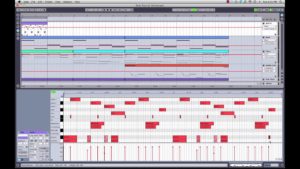
Ableton Live 9 allows you to transition from live audio to midi, with one simple click.
I’ve been using this feature to transform my guitar parts, into midi parts.
I think Ableton is a great writing tool, in addition to being a great DAW.
How I Create Quick Melody Variations with Midi in Ableton
One simple midi trick in Ableton, is to use the doubletime, or halftime button to test variations of your melody.
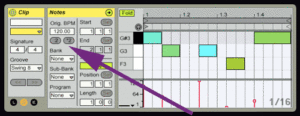 Just click the +2, or :2 button, when you are working with a clip.
Just click the +2, or :2 button, when you are working with a clip.
Your midi notes will become half speed, or double-time.
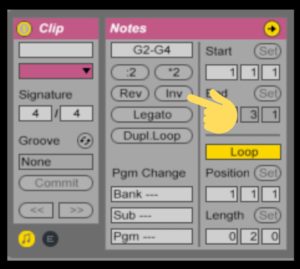 You can also invert the melody, or put it in reverse, with just one click.
You can also invert the melody, or put it in reverse, with just one click.
This is great when you are create additional loops, to be arranged later in Arrangement View.
Here are some additional Midi Tricks:
1. Hold SHIFT with your UP/DOWN arrow keys (or trackpad) to Transpose by an octave instead of 1 semitone.
2. Midi notes can be quantized (placed directly on the beat) with the hotkey command-U.
Using Midi Effects to Alter Your Melody
A great feature of the Ableton DAW are its Midi Effects.
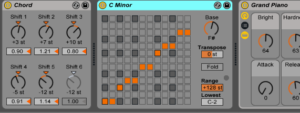 Midi effects allow you to change the speed, pitch, rhythm, scale, and more by dragging a midi effect into your track.
Midi effects allow you to change the speed, pitch, rhythm, scale, and more by dragging a midi effect into your track.
I love to try unusual scales with my midi parts, using MIDI Effects.
It’s very easy to drag a Harmonic minor, or Ukrainian Dorian scale onto your midi part, for example, with one click.
Other types of midi effects allow you to change the note length, velocity, add an arppegiator, even add glitches for effect.
The video below goes a little more in depth with Midi Effects:
Transforming a Live Guitar Signal into Midi Notes in Ableton 9
I just learned that you can turn a live guitar signal into midi notes as a new feature in Ableton Live 9.
 I’ve been playing guitar since i was 10.
I’ve been playing guitar since i was 10.
Its been difficult to translate guitar performance into electronic music, because most controllers are keyboards.
 But, in Ableton Live 9, all you have to do is ‘right click’ on your audio part, then click ‘convert melody to midi track’.
But, in Ableton Live 9, all you have to do is ‘right click’ on your audio part, then click ‘convert melody to midi track’.
You can even convert chords into midi, by converting ‘Harmony to Midi’.
This ‘audio to midi’ feature works with any type of live audio, like strings, piano, etc. (But, i’m sure some stuff will convert better than others)
The video below explains it a little more in depth:
Slice a Drum Loop or Sample into a Midi Track
The Slice to Midi feature allows you to ‘cut up an audio file into slices’, which can then be controlled via midi notes.
 This is especially cool for drum loops.
This is especially cool for drum loops.
Its easy to slice up any drum loop into a brand new drum kit, which you can control via midi.
I did a quick test of the slice to midi feature with a Neil Degrass Tyson vocal clip.
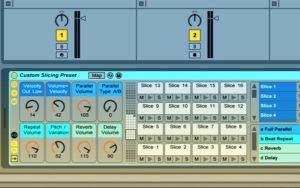 It was really cool to control these sliced up vocal snippets, via midi and automation.
It was really cool to control these sliced up vocal snippets, via midi and automation.
You can even alter the vocal parts with pitch bend, LFOs, and other types of midi controls.
Warping in Midi
Ableton lets you easily warp a sample to fit ANY tempo, by placing warp markers at key points on your sample.
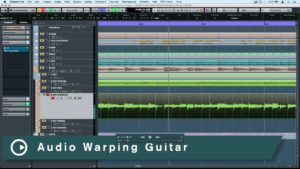
I haven’t really gone too in depth with sample warping in my music, but I can see myself using it with vocal samplea.
It allows you to stretch or compress a sample with ‘warp markers‘ which are easily adjustable, instead of stretching or compressing each part of the sample individually, like i would do in Pro Tools.
Here’s a vid that better explains how to warp your samples to fit any tempo:
There are MANY new features that i am testing in Ableton. But i’m still learning, so if you have any midi tricks that you think i should include, let me know @puzzlevortex